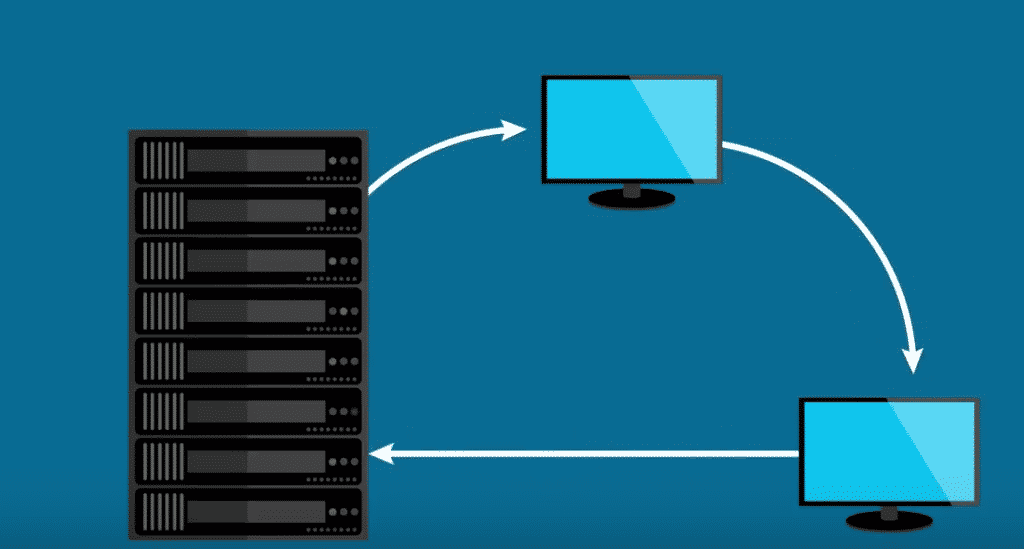IBM MQSeries (renamed MQ in 2014) is a family of message-oriented middleware developed by IBM. This middleware enables communication between disparate IT systems and infrastructures through messaging. Discover everything you need to know about IBM MQ.
In the field of IT architecture, middleware refers to software that enables the creation of a network for information exchange between different applications. This allows disparate applications to work together. The network is established using the same information exchange technique across all involved applications, facilitated by software components.
These software components provide communication between applications, regardless of the differences in computers, network protocols, operating systems, and the specific hardware and software characteristics of computer networks. Commonly used information exchange techniques include message exchange, remote procedure calls, and remote object manipulation.
IBM MQSeries (MQ): What Is It?

IBM MQ is a family of middleware software developed by IBM, one of the leaders in cloud computing. Specifically, IBM MQ falls into the category of MoM (message-oriented middleware). Its software components utilize the information exchange technique through message exchange.
This technique operates similarly to email. An application sends a message, which is then transmitted to the recipient application via the software components. Meanwhile, the sending application can continue processing other tasks. Messages can be directed to a specified application by the sender, a list of subscribed applications, or broadcast to all applications that use the middleware.
The goal of IBM MQ is to connect various IT systems, across different geographical locations and disparate IT infrastructures, ensuring smooth operations. It enables communication between applications or between users and groups of applications across varied systems.
IBM MQSeries (MQ): How Does It Work?

IBM MQ encompasses three products. MQ Series Messaging facilitates communication between applications on different platforms. MQSeries Integrator allows for centralized management and enforcement of company-defined rules. MQSeries Workflow enables the capture, visualization, and automation of processes.
Messages are collections of binary files or character data like ASCII or EBCDIC. Similar to other communication protocols, information storage, routing, and delivery are added to the message before transmission and removed before delivery to the receiving application.
Another component of IBM MQ is the message queues, which are objects for storing messages within an application. The Queue Manager is a logical container for message queues. It is responsible for transferring data to other Queue Managers through message channels.
IBM MQSeries (MQ): What Are the Compatible Platforms?
The IBM MQSeries software family was launched by IBM in 1993. In 2002, MQSeries was renamed WebSphere MQ to join the IBM WebSphere product suite. In 2014, the name IBM MQ was finalized. The IBM MQ family includes IBM MQ, as well as IBM MQ Advanced, IBM MQ Appliance, and IBM MQ for z/OS.
IBM MQ’s wide adoption is largely due to its compatible platforms. Compatible platforms include z/OS (mainframe), OS/400 (IBM System i or AS/400), Transaction Processing Facility, UNIX (AIX, HP-UX, Solaris), HP NonStop, OpenVMS, Linux, OS 2200, and Microsoft Windows. According to IBM, IBM MQ can connect any pair of commercial systems used by businesses today.
IBM MQ 9.4.3: Latest Features and Future Direction
To meet the growing needs of users, IBM is continually enhancing its capabilities. The latest version, IBM MQ 9.4.3, was announced on June 10, 2025, and became available on June 17. This new version is part of the 9.4 Long Term Support stream.
It aims to address enterprise needs in terms of security, productivity, and resilience in an environment where data exchanges are increasingly critical. The goal is to provide a messaging platform capable of adapting to modern hybrid environments without complicating the workloads of technical teams.
Security is a top priority. IBM MQ improves the management of JSON Web tokens, and enhanced audit logs for container deployments allow compliance with strict standards such as the American FISMA. Organizations subject to regulatory constraints find this to be a significant advantage.
On the productivity front, multiple enhancements aim to simplify the lives of administrators. The MQ-Ansible collection, an optimized MQ console, and the integration of the Kafka Connect framework facilitate further automation. Additionally, these improvements help reduce operational overhead and streamline communications between services. Java developers will also benefit from simplified JWT authentication, eliminating unnecessary lines of code. Finally, resilience is built into hybrid cloud architectures. High availability inter-regional replication, already appreciated, becomes accessible to more environments, ensuring service continuity even in the event of a major incident.
FAQ
IBM MQSeries, now known as IBM MQ, is message-oriented middleware. It enables different applications, sometimes running on very different systems, to exchange data reliably through message sending. It ensures stable communication, even when some applications may not be available at the same time.
Kafka is designed for processing large amounts of continuous data, often used for real-time analysis or event streaming. IBM MQ, on the other hand, focuses on reliability and guaranteed message delivery, even during failures. Kafka is optimal for speed and streaming, while IBM MQ emphasizes robustness and transactional security.
MQSeries on mainframe refers to the use of IBM MQ on IBM z/OS systems. These environments are common in large banking, governmental, or industrial organizations. The middleware ensures reliable communication between critical applications running on the mainframe and other internal or external systems.
IBM MQ is used to connect applications and services securely, reliably, and in an orderly manner. It guarantees that messages sent by an application are received, even if the recipient system is temporarily unavailable. Its role is crucial in critical operations where data loss is unacceptable.




